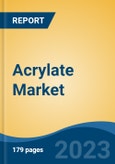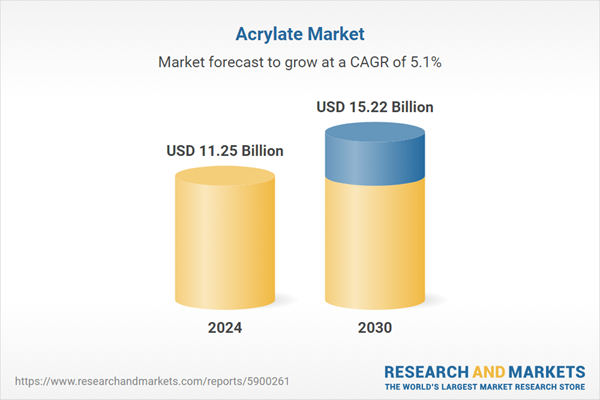Speak directly to the analyst to clarify any post sales queries you may have.
10% Free customizationThis report comes with 10% free customization, enabling you to add data that meets your specific business needs.
Market growth is being fueled by rising demand in the spray coating and packaging industries, infrastructure upgrades, increasing disposable incomes, and the growing adoption of water-based emulsions. Additionally, the automotive industry’s shift towards lightweight materials and the development of bio-based acrylic acid present promising opportunities. However, challenges such as health and environmental risks associated with acrylate exposure may limit growth potential in certain regions.
Key Market Drivers
Growing Demand of Acrylate in Automotive Industry
The automotive sector is a major consumer of acrylates, leveraging their properties in the production of coatings and adhesives. Acrylate-based coatings offer enhanced durability, corrosion resistance, and aesthetic appeal for both interior and exterior applications such as body panels and trim. Furthermore, acrylates are used in sealants and adhesives critical to vehicle assembly and maintenance. As the industry pivots toward lightweight and fuel-efficient vehicles, acrylates are increasingly replacing traditional mechanical fasteners to reduce overall vehicle weight. This shift supports improved fuel economy and aligns with global emissions standards, thereby driving continued demand for acrylate materials in automotive manufacturing.Key Market Challenges
Volatility in Prices of Raw Materials
The acrylate industry is heavily reliant on petroleum-based feedstocks such as acrylic acid and various alcohols. These raw materials are sensitive to fluctuations in crude oil prices, creating cost instability for manufacturers. Spikes in oil prices elevate production expenses and compress profit margins, while price drops may lead to oversupply and market imbalances. This volatility disrupts procurement, pricing, and long-term financial planning for companies in the acrylate sector. As such, maintaining profitability requires proactive cost management strategies and close monitoring of global energy trends to navigate the unpredictable raw material landscape.Key Market Trends
Increasing Adoption of UV-Curable Acrylate
UV-curable acrylates are gaining popularity due to their fast curing time, low energy requirements, and solvent-free formulation, which makes them more environmentally friendly compared to traditional alternatives. These acrylates are widely used in coatings, adhesives, and printing inks. In the coatings industry, they deliver durable, high-performance finishes for wood, plastic, and metal surfaces, while in adhesives, they provide strong bonding for electronics and medical devices. Their ability to adhere to multiple substrates and their suitability for high-speed production make them a preferred choice across industries. As sustainability and efficiency become critical business goals, the adoption of UV-curable acrylates is expected to accelerate.Key Market Players
- Arkema SA
- BASF SE
- Evonik Industries AG
- LG Chem Ltd.
- SIBUR International GmbH
- The DOW Chemical Company
- Sasol Limited
- Mitsubishi Chemical Corporation
- Formosa Plastics Corporation
- Nippon Shokubai Co., Ltd
Report Scope:
In this report, the Global Acrylate Market has been segmented into the following categories, in addition to the industry trends which have also been detailed below:Acrylate Market, By Chemistry:
- Butyl Acrylate
- Ethyl Hexyl Acrylate
- Methyl Acrylate
- Ethyl Acrylate
Acrylate Market, By End User:
- Packaging
- Consumer Goods
- Building & Construction
- Textile
- Automotive
- Others
Acrylate Market, By Region:
- North America
- United States
- Canada
- Mexico
- Europe
- France
- United Kingdom
- Italy
- Germany
- Spain
- Asia-Pacific
- China
- India
- Japan
- Australia
- South Korea
- South America
- Brazil
- Argentina
- Colombia
- Middle East & Africa
- South Africa
- Saudi Arabia
- UAE
Competitive Landscape
Company Profiles: Detailed analysis of the major companies present in the Global Acrylate Market.Available Customizations:
With the given market data, the publisher offers customizations according to a company's specific needs. The following customization options are available for the report.Company Information
- Detailed analysis and profiling of additional market players (up to five).
This product will be delivered within 1-3 business days.
Table of Contents
Companies Mentioned
- Arkema SA
- BASF SE
- Evonik Industries AG
- LG Chem Ltd.
- SIBUR International GmbH
- The DOW Chemical Company
- Sasol Limited
- Mitsubishi Chemical Corporation
- Formosa Plastics Corporation
- Nippon Shokubai Co., Ltd
Table Information
| Report Attribute | Details |
|---|---|
| No. of Pages | 180 |
| Published | June 2025 |
| Forecast Period | 2024 - 2030 |
| Estimated Market Value ( USD | $ 11.25 Billion |
| Forecasted Market Value ( USD | $ 15.22 Billion |
| Compound Annual Growth Rate | 5.1% |
| Regions Covered | Global |
| No. of Companies Mentioned | 10 |









